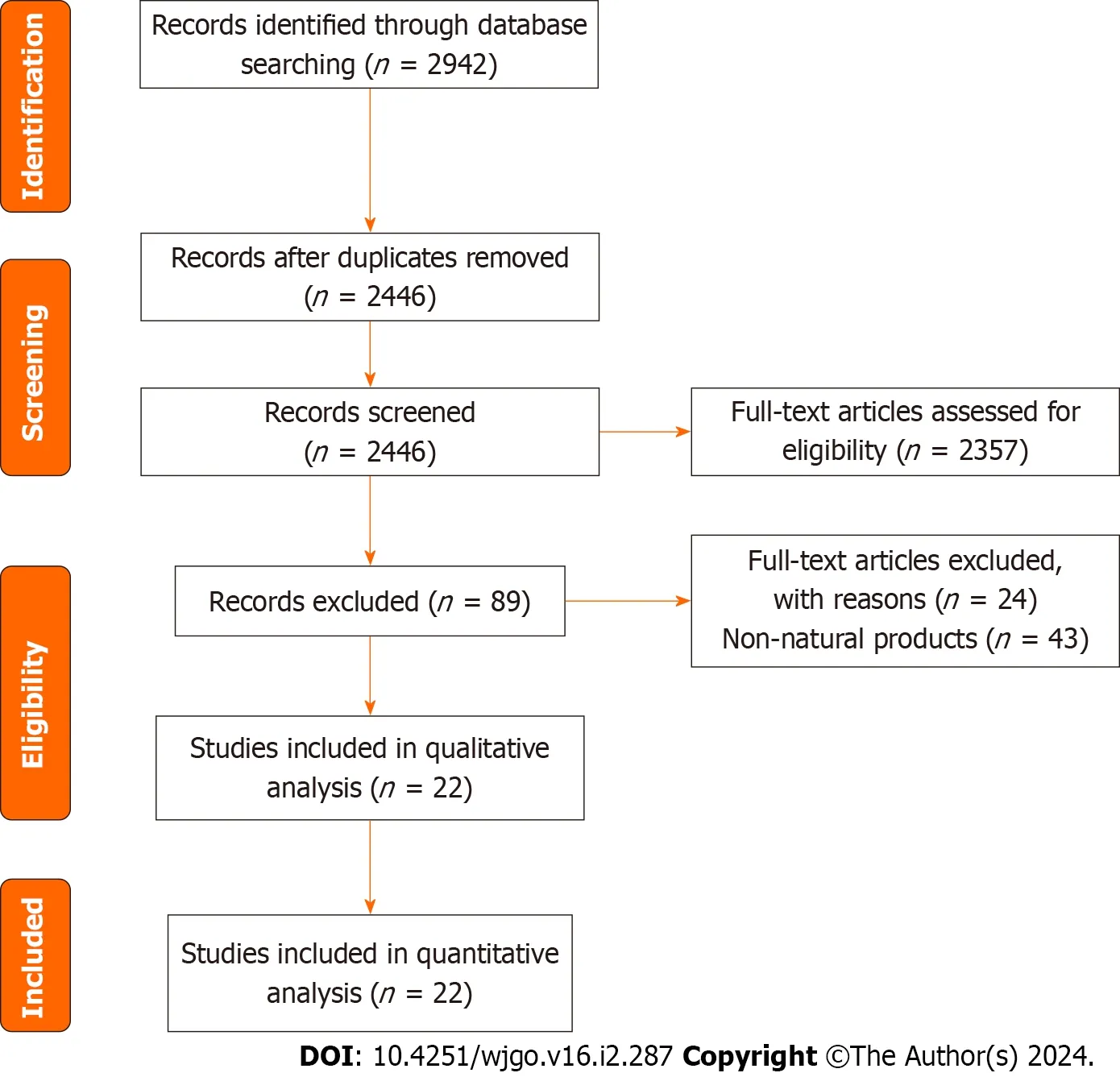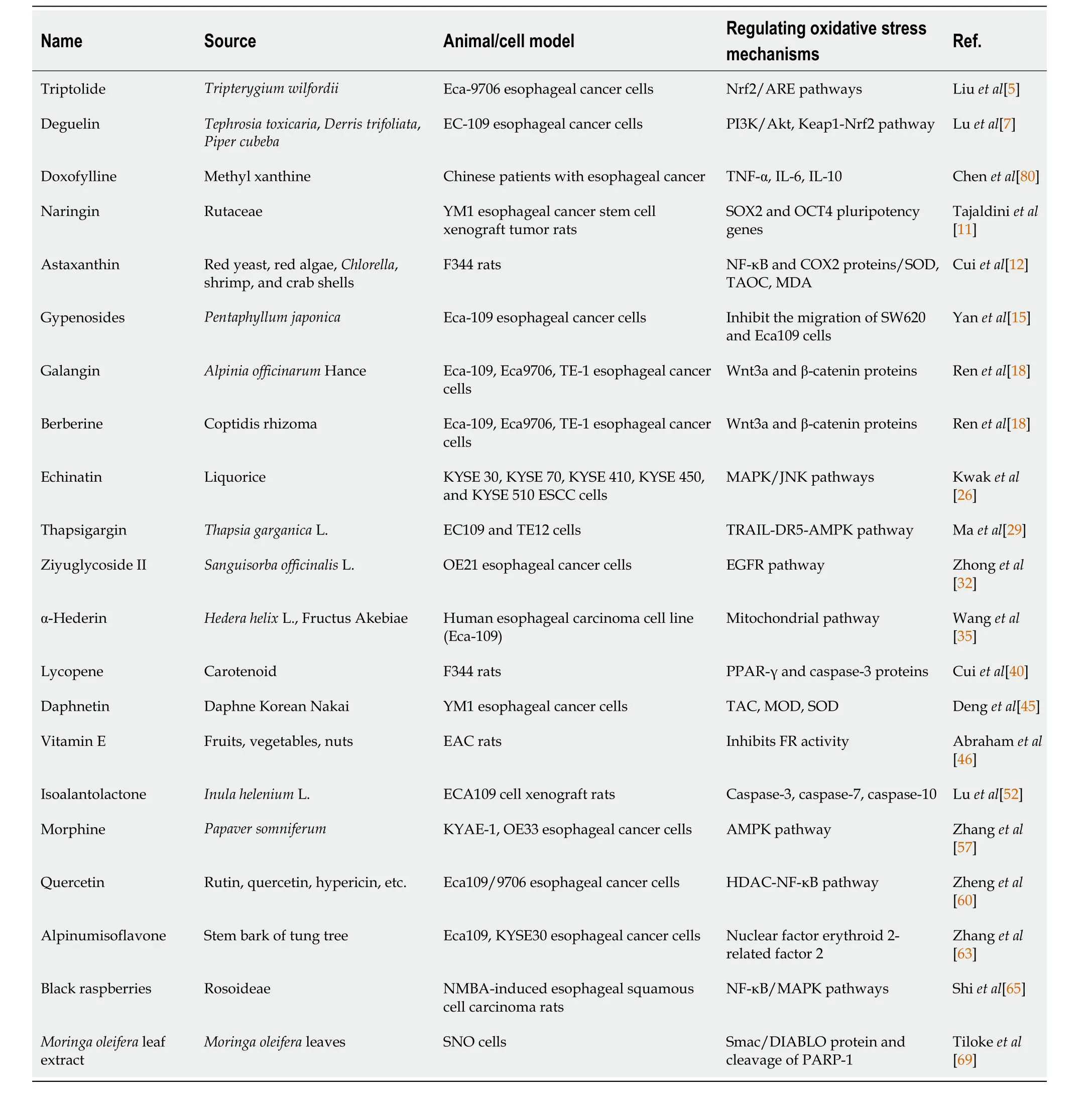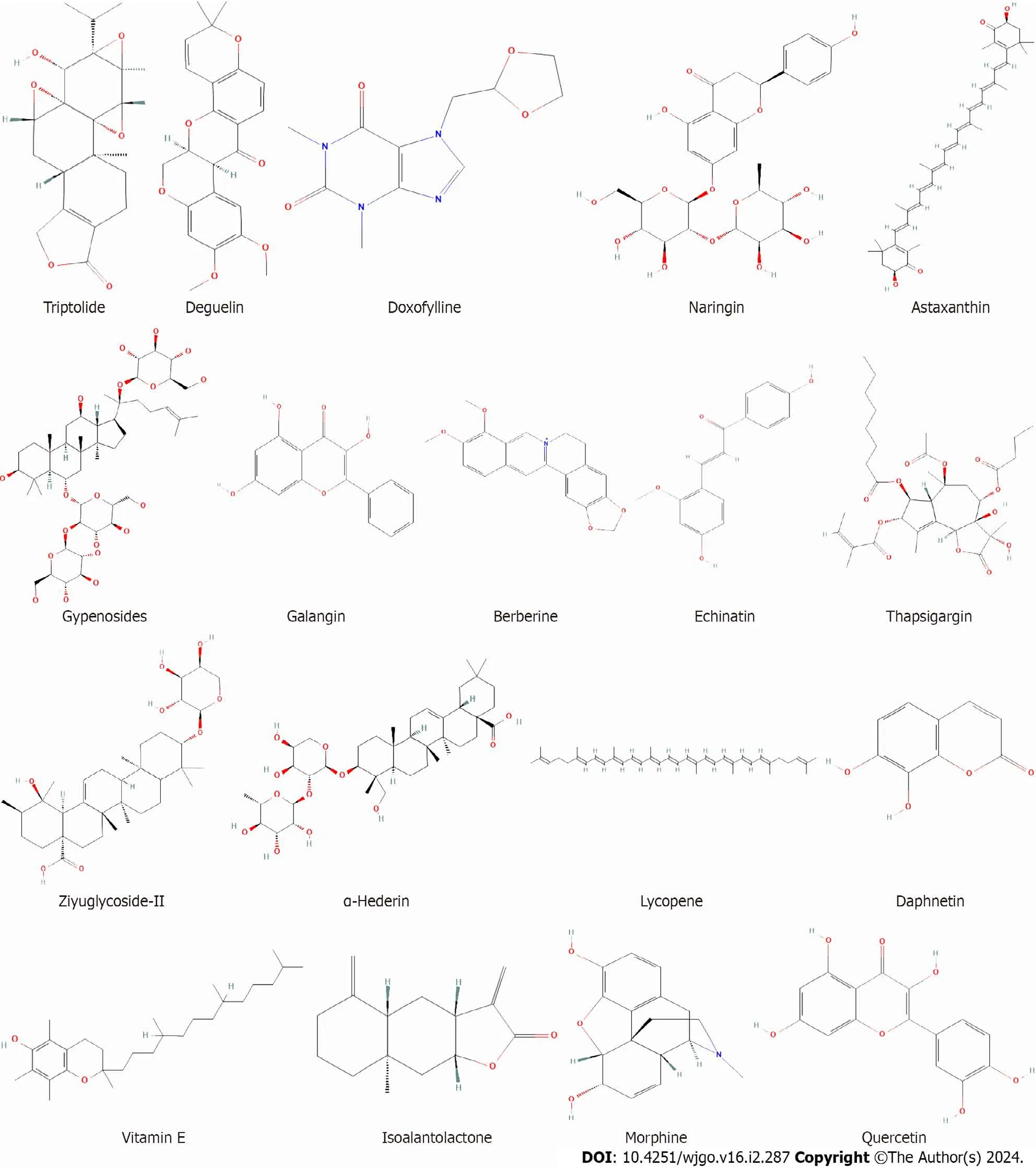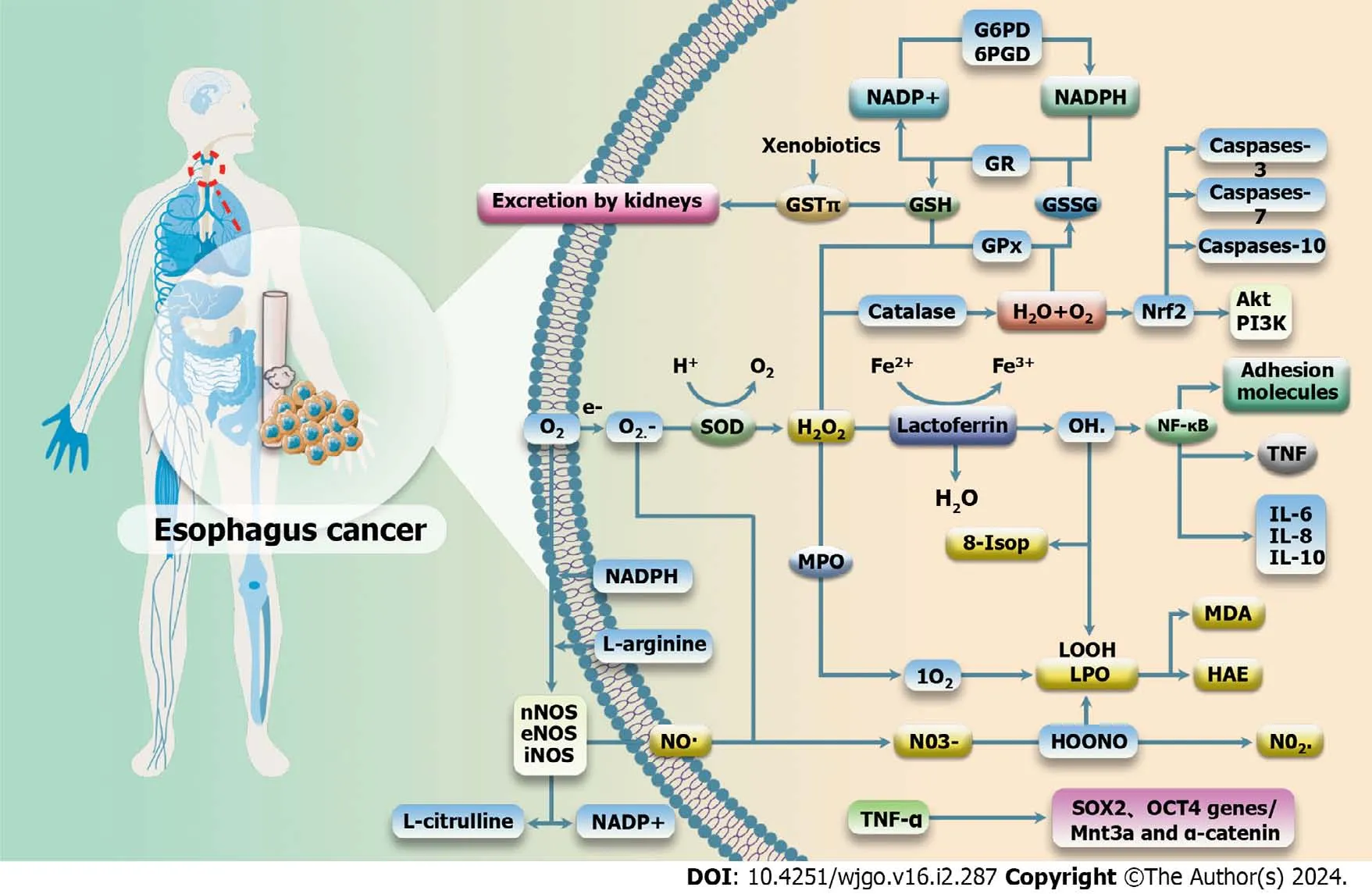Targeting oxidative stress with natural products: A novel strategy for esophageal cancer therapy
Fang Cao,Han-Ling Zhang,Cui Guo,Xue-Liang Xu,Qiang Yuan
Abstract Esophageal cancer (ESC) is a malignant tumor that originates from the mucosal epithelium of the esophagus and is part of the digestive tract.Although the exact pathogenesis of ESC has not been fully elucidated,excessive oxidative stress is an important characteristic that leads to the development of many cancers.Abnormal expression of several proteins and transcription factors contributes to oxidative stress in ESCs,which alters the growth and proliferation of ESCs and promotes their metastasis.Natural compounds,including alkaloids,terpenes,polyphenols,and xanthine compounds,can inhibit reactive oxygen species production in ESCs.These compounds reduce oxidative stress levels and subsequently inhibit the occurrence and progression of ESC through the regulation of targets and pathways such as the cytokine interleukins 6 and 10,superoxide dismutase,the NF-+ACYkappa+ADs-B/MAPK pathway,and the mammalian Nrf2/ARE target pathway.Thus,targeting tumor oxidative stress has become a key focus in anti-ESC therapy.This review discusses the potential of Natural products (NPs) for treating ESCs and summarizes the application prospects of oxidative stress as a new target for ESC treatment.The findings of this review provide a reference for drug development targeting ESCs.Nonetheless,further high-quality studies will be necessary to determine the clinical efficacy of these various NPs.
Key Words: Oxidative stress;Natural products;Esophageal cancer;Reactive oxygen species
lNTRODUCTlON
Esophageal cancer (ESC) is a malignant tumor originating from the mucosal epithelium of the esophagus in the digestive tract[1].These tumors can be categorized into esophageal squamous cell carcinoma (ESCC) and esophageal adenocarcinoma based on histological classification[2].Globally,ESC ranks seventh in terms of incidence (3.1%) and sixth in mortality (5.5%)[3].Regional disparities in ESC incidence rates have been reported and are primarily concentrated in Central Asia,East Asia,South Asia,East Africa,and South Africa.The age-standardized incidence rates of ESC are 17.5/100000 individuals in high-incidence countries and less than 1/100000 individuals in low-incidence countries[1].The pathogenesis of ESC involves various factors,such as gene mutations,RNA interference,and inflammatory responses.Environmental-genetic-gene interactions are risk factors for esophageal carcinogenesis[4].Currently,clinical treatments for ESC mainly involve radiotherapy and surgery,but these approaches often lead to adverse reactions and poor patient prognosis[5].
Recently,targeted therapy has gained prominence in cancer treatment.However,molecular targets for digestive tract tumors are limited,impeding progress in precision treatment[6].Oxidative stress-targeting agents have shown significant efficacy in treating various solid tumors,including ESCs[7].Although the specific mechanisms underlying ESC development are unclear,the oxidative stress response plays a crucial role in the growth,invasion,and metastasis of ESC cells[8].During the occurrence and development of ESCs,cancer cells experience oxidative stress,which leads to excessive free radical production,damage to DNA fragments,or changes in the expression of certain genes,thereby promoting tumor cell proliferation,invasion,and metastasis[9].Accumulating evidence has increasingly suggested the close association between oxidative stress and ESCC,turning this relationship into a burgeoning research focus.
Natural products (NPs) are chemical compounds that exist in nature and are produced by living organisms.They originate from various biological sources,such as plants,animals,or microorganisms,and exhibit a diverse array of structures and functions[10].NPs have garnered considerable attention worldwide owing to their unique properties and potential medicinal value[11].In recent decades,these compounds have become integral to drug discovery and development,playing crucial roles in cancer treatment[12].Numerous active ingredients with anticancer activity have been discovered,and they act directly on tumor cells.These active compounds,including polyphenols (e.g.,quercetin)[13] and flavonoid compounds (e.g.,alpinumisoflavone),reduce oxidative stress in cancer cells by inhibiting reactive oxygen species (ROS) production,increasing antioxidant enzyme activity,regulating related signaling pathways,and modulating mitochondrial function.They have also demonstrated anticancer effects against tumors of the digestive tract.The close association between cancer cells and oxidative stress has expanded the application of NPs in ESC treatment,attracting researchers' attention to their anticancer effects.This review is the first comprehensive study on the mechanisms by which NPs regulate oxidative stress responses in ESCs.These findings are expected to offer preclinical evidence for the use of NPs for preventing and managing ESC and facilitating their translation into clinical practice.
METHODOLOGY
We conducted a thorough literature review of the PubMed,Embase,Web of Science,Science Direct,and China National Knowledge Infrastructure databases spanning from the original publication date to July 2023 to explore the mechanisms by which NPs inhibit ESCs by targeting oxidative stress.The search criteria encompassed four types of subject words and keywords: (1) "ESC" and related synonyms such as "esophageal carcinoma","esophageal tumor",and “esophagus tumor”;(2) “Oxidative stress” was also searched.To broaden the scope of the search process,we also included articles containing terms such as “ROS”,"superoxide dismutase (SOD)”,"malondialdehyde (MDA)",and "glutathione (GSH)";and (3) "NPs" and its synonyms,including "phytonutrient","herb","biological","plant-derived","phytochemical","medicinal plant",and "plant bioactive compound",were also included.The initial database search yielded 2942 records.After removing duplicates,2446 unique studies were evaluated based on their titles and abstracts.Subsequently,430 articles were excluded,and 22 full-text articles were ultimately assessed.A flowchart of the search process is depicted in Figure 1.

Figure 1 Flowchart of the literature search and study selection.
FEATURES OF ESC OXlDATlVE STRESS lN ESCS
ROS play pivotal roles in not only cell death and necrosis but also intercellular signal transduction and gene expression regulation,thereby contributing to tumorigenesis[14].Under normal physiological conditions,ROS maintain a balanced redox system and are vital for human physiological processes.However,excessive ROS can induce DNA damage,lipid peroxidation,enzyme activation or inactivation,and disruption of intracellular antioxidant defense systems[15].In their study on ESCs,Konget al[16] discovered that oxidative stress can cause DNA damage in esophageal cells and interfere with the DNA repair system.Among the modified products of DNA oxidative damage,8-hydroxy-2'-deoxyguanosine has emerged as the most commonly used biomarker.Numerous studies have shown that most tumor cells possess impaired antioxidant stress systems,and ROS significantly influence both cell death and survival[17].Oxidative stress can lead to DNA base alterations,strand breaks,upregulation of proto-oncogenes,and downregulation of suppressor genes within cells,all of which are closely associated with the development of various tumors[12].An imbalance between oxidants and antioxidants in the body is believed to critically contribute to this process (Figure 2).

Figure 2 Features of esophageal cancer oxidative stress.SOD: Superoxide dismutase;MDA: Malondialdehyde;TAOC: Total antioxidant capacity;ROS: Reactive oxygen species;TNF-α: Tumor necrosis factor alpha.
The interaction between ESC cells and oxidative stress is complex.On the one hand,ESC cells increase ROS production by enhancing their metabolic activity and altering energy metabolic pathways.On the other hand,high levels of ROS can cause DNA damage,abnormal protein folding,lipid peroxidation,and other cellular structural and functional abnormalities,thereby promoting and altering the proliferation,invasion,and metastasis of ESC cells[1].In ESC,the expression and activity of antioxidant enzymes are typically increased to help combat the overproduction of ROS[2].These antioxidant enzymes include SOD,glutathione peroxidase (GPx),and glutathione reductase (GR).SOD converts superoxide radicals into more stable molecular oxygen and peroxide anions,while GPx and GR participate in the GSH system,converting harmful peroxides into harmless substances by catalyzing reduction reactions[1,3].Hence,oxidative stress response plays a crucial role in the development of ESC.Simultaneously,effectively inhibiting oxidative stress in ESC cells holds potential as a promising research direction in the field of ESC prevention and treatment.
NPS REGULATE OXlDATlVE STRESS lN ESC
Triptolide
Triptolide (TP),an abietane-type diterpenoid isolated fromTripterygium wilfordii Hook. F,possesses potent antitumor,immunosuppressive,and anti-inflammatory properties[4].TP exerts its anticancer effect primarily through inducing apoptosis[5,6].TP can promote apoptosis in Eca-9706 cells by stimulating damage due to oxidative stress and inhibiting stress reduction reactions (Table 1 and Figure 3).

Table 1 Natural compounds regulating oxidative stress in esophageal cancer therapy

Figure 3 The structural formulae of natural products targeting oxidative stress.
Deguelin
Deguelin,the most common rotenone compound in plants apart from rotenone itself,is found in the roots of Tephrosiatoxicaria,Derris trifoliata,Piper cubeba,and the leaves of Tephrosia vogelii.Which has pharmacological effects such as antiviral and anti-tumor effects.In recent years,deguelin has been discovered to possess strong anticancer activity[7].Deguelin induces cell apoptosis by blocking anti-apoptotic pathways such as PI3K-Akt,IKK-IκBα-NF-κB,and AMPKmTOR-survivin.Some results demonstrated that increasing deguelin concentration significantly inhibits the proliferation of ESC EC-109 cells and plays a crucial role in inducing apoptosis.
Doxofylline
Doxofylline is a novel methylxanthine derivative known for inhibiting phosphodiesterase and exerting effects on airway expansion,anti-bronchospasm,and improved ventilation function[8].Doxofylline is involved in the oxidative stress response of cancer cells and exhibits immune regulation,anticancer,and anti-inflammatory properties[9].Another study revealed that doxofylline reduces inflammatory response and oxidative stress in patients undergoing radical resection of ESC.
Naringin
Naringin (NR),also known as NR,citrin,and isohesperidin,is a dihydroflavonoid mainly found in the peel and pulp of grapefruit,tangerine,and orange in the Rutaceae family[10].NR is a dihydroflavonoid.Because no conjugation exists between ring A and ring B,NR has a strong ultraviolet absorption peak at 282 nm,which makes it display a variety of biological activities and pharmacological effects,including anti-inflammatory,anticancer,and immunomodulatory effects.Tajaldiniet al[11] showed that doxorubicin combined with NR resulted in reduced systemic toxicity and decreased fractional cycling of oxidative stress.
Astaxanthin
Astaxanthin (AST),a carotenoid present in various organisms such as red yeast,red algae,chlorella,shrimp,and crab shells.In addition to its carotenoid functions that alleviate visual fatigue and prevent light damage,it also has strong pharmacological properties such as antioxidant,anti-tumor,and immune enhancement.Cuiet al[12] revealed that AST inhibits NF-κB and COX expression,improves antioxidant capacity and anti-inflammatory ability,and significantly inhibits the occurrence of ESC.Another study by Cuiet al[12] demonstrated that AST inhibits oxidative stress by increasing the levels of SOD and total antioxidant capacity (TAOC) in serum while inhibiting the levels of MDA and increasing the protein expression of PPARγ,Bax/Bcl-2,and caspase-3 in esophageal tissues,thus providing protective effects against ESC.
Gypenosides
Gypenosides (GP),the effective components of Pentaphyllum japonica,a traditional Chinese medicine,exhibit significant pharmacological activities such as cancer inhibition,anti-inflammatory,and blood pressure lowering[13].GP plays a role in cellular self-repair,promotes cancer cell recovery,prevents tumor recurrence and metastasis,and inhibits the proliferation of nearly all cancer cells[14].Yanet al[15] demonstrated that GP inhibits the proliferation and migration of ESC Eca-109 cells in a dose-and time-dependent manner.It increases intracellular ROS levels,reduces mitochondrial membrane potential,and induces apoptotic morphologies such as cell shrinkage and chromatin condensation,indicating that oxidative stress and mitochondria-dependent apoptosis are involved in GP-induced loss of cell viability in ESC Eca-109 cells.
Galangin
Galangin (3,5,7-trihydroxyflavone),a natural flavonol compound,is the main active ingredient in the rhizoma of galangal,a traditional Chinese medicine[16].It possesses anti-inflammatory,free radical scavenging,and anti-cancer effects[17].Available data suggest that galangin,as a free radical scavenger,exhibits various pharmacological activities and confers resistance against the growth of different tumors.Renet al[18] found that galangal plays a crucial role in inhibiting the proliferation of ESC cells by inhibiting the activity of cyclins and cyclin-dependent kinases.Additionally,galangin enhances the expression of P53 and its family members P21 and P27,further inhibiting the growth of cancer cells[19].Moreover,galangin exerts its influence by inhibiting the PI3K/JAK2/STAT3 signaling pathway,which becomes activated in the presence of ROS.Galangin reduces ROS levels and inhibits the activity of this signaling pathway,thereby effectively inhibiting the growth and survival of ESC cells[20].
Berberine
Berberine (BBR) is a quaternary ammonium bioactive base isolated from the traditional Chinese medicine Coptidis rhizoma,known for its various pharmacological effects such as anti-inflammatory and antibacterial effects and participation in cellular oxidative stress response[21,22].It inhibits cancer cell proliferation and induces cancer cell apoptosis[23].Moreover,BBR has shown potential in inhibiting cell proliferation,invasion,and metastasis in different cancers through cell cycle arrest,senescence,apoptosis,and autophagy of tumor cells,making it a promising anticancer drug.In the study by Jianget al[24],the effects of BBR on ESCC line KYSE-70 and esophageal adenocarcinoma cell line SKGT4 were evaluated.The results showed that BBR inhibited EC cell growth by promoting cell cycle arrest and apoptosis in G2/M phase.
Echinatin
Echinatin (Ech),a compound extracted from licorice,a classic Chinese herbal medicine,demonstrated multiple biological activities,especially in terms of antitumor and anti-angiogenesis activities,garnering extensive attention in recent years[25].The results of Kwaket al[26] showed that Ech induced apoptosis in human ESC cells by increasing ROS levels,endoplasmic reticulum (ER) stress,and p38 MAPK/JNK activation.
Thapsigargin
Thapsigargin (TG),derived from Thapsia garganica L.,a plant known for its potential anticancer properties,has demonstrated promising activity against various types of tumor cells[27].It exerts its effects by inducing ER stress and apoptosis,thereby inhibiting cancer growth.CHOP,a key transcription factor,plays an important role during ER stress.In this context,forced expression of CHOP can upregulate the expression of death receptor 5 (DR5) and promote oxidative stress and cell death[28].TG effectively activates the ER stress response,while an increased protein folding load in the ER leads to ROS accumulation[28].Maet al[29] revealed that TG enhances the sensitivity of human ESC cells to TRAIL-induced apoptosis by depleting the cellular TAOC and increasing ROS levels in human ESCC cells.
Ziyuglycoside II
Ziyuglycoside II (ZYG II),derived fromSanguisorba officinalis L.,is a triterpene saponin with good anti-inflammatory and anticancer properties[30].It exerts its pharmacological effects mainly by inducing ROS production and apoptosis[31].Zhonget al[32] demonstrated that ZYG II significantly induces apoptosis of digestive tract tumor cells by regulating cell cycle progression,mediating oxidative stress,and blocking the epidermal growth factor receptor (EGFR) signaling pathway,thereby promoting the anticancer effect of 5-fluorouracil (5-FU).
α-Hederin
α-Hederin belongs to the monosaccharide chain pentacyclic triterpene saponins,and it is found in various plants such asHedera helix L.,Fructus Akebiae,and Nigella sativa L[33].It has been shown to possess various pharmacological effects,including antitumor,anti-inflammatory,antispasmodic,and anti-leishmaniasis properties[34].In the study by Wanget al[35],the antitumor effect of α-hederin was evaluatedin vivousing the human ESC cell line Eca-109.The results demonstrated that α-hederin significantly inhibited ESCC cell proliferation,induced cell apoptosis,and arrested the cell cycle at the G1 phase.α-Hederin inhibits ESCC cell proliferation and induces apoptosis by dispersing mitochondrial membrane potential (MMP) and simultaneously generating ROS and activating the mitochondrial pathway.
Lycopene
Lycopene,a type of carotene found in plant foods,it has pharmacological effects such as enhancing the body's oxidative stress capacity,anti-inflammatory effects,antioxidant effects,and enhancing immunityis abundant.It can be found in ripe red plant fruits,particularly in tomatoes,carrots,and guavas[36].Unlike β-carotene,lycopene lacks the β-angelone ring structure,preventing its conversion into vitamin A in the body[37,38].Although it lacks the physiological activity of vitamin A,lycopene possesses a potent antioxidant function[38,39].Cui,Linglinget alrevealed that an appropriate dose of lycopene effectively reduces the incidence of ESC induced by JV-nitrosomethylbenzylamine (NMBzA) in F344 rats.Lycopene significantly reduces the expression of PPARγ,NF-κB,COX-2,and caspase-3 proteins involved in oxidative stress,exhibiting anti-inflammatory and pro-apoptotic effects[40].
Daphnetin
Daphnetin (DAP) is an active ingredient extracted fromDaphne Koreana Nakai,also known asZushimazin[41].It is the first new drug in China and is chemically named 7,8-dihydroxycoumarin.Its pharmacological effects primarily involve triggering ROS-induced apoptosis and inhibiting the production of tumor necrosis factor-α,interleukin-1β,ROS,and MDA[42-44].Daphnetin demonstrates remarkable anti-inflammatory,antioxidant,and anticancer abilities.In vivoexperiments have shown that DAP administration as a standalone treatment reduces tumor volume and slightly increases body weight in experimental mice.Furthermore,co-administration of Dox and DAP not only reduces tumor volume but also preserves body weight,indicating that DAP exerts a protective effect against oxidative stressin vivo[45].
Vitamin E
Vitamin E is an essential fat-soluble vitamin in the human body[46].It serves as a crucial nonenzymatic,chain-breaking antioxidant distributed in the cell membrane of aerobic organisms.Its pharmacological effects mainly include antioxidant,anticancer,vascular protection,and regulation of hormone levels in the body.Vitamin E effectively prevents and reduces nonenzymatic oxidative damage to DNA and lipids caused by free radicals or ROS and plays a protective role in biofilm[47,48].A study by Eskelsonet aldemonstrated that ethanol increased the incidence of NMBzA-induced esophageal tumors by 174%,while a vitamin E-supplemented diet reduced the incidence of ethanol-induced esophageal tumors by 32%.Mice supplemented with vitamin E also showed a reduced number of esophageal tumors,suggesting that vitamin E exerts a protective effect by interrupting the chain reaction of free radicals[49].
Isoalantolactone
Alantolactone is a perennial herb belonging to the genus Inula in the Asteraceae family.The root of Inula helenium L.contains a large amount of sesquiterpene lactones,mainly including alantolactone and isoalantolactone (IAL)[50].IAL possesses various biological activities such as anti-inflammatory,antioxidant,antitumor,and neuroprotective effects.It exhibits cytotoxic effects on a variety of cancer cells but has no significant toxicity on normal cells[51].Luet al[52] demonstrated that IAL induces apoptosis in human ESC cells by activating caspase-3,-7,and -10 and upregulating DR5 (an extrinsic pathway).This process involves upregulating DR5 and increasing ROS.
Morphine
Morphine is an NP extracted from the milk of the poppy plant (Papaver somniferum)[53].This plant is a perennial herb mainly found in the Mediterranean region and some parts of Asia.It is widely used in medicine to alleviate severe pain due to its powerful analgesic,sedative,and cough relieving pharmacological effects,especially after surgery or during cancer treatment or severe trauma[54].Morphine also plays an important role in ESC treatment[55,56].Zhanget al[57] demonstrated that morphine activates the AMP-activated protein kinase (AMPK) pathway,induces epithelialmesenchymal transition,and increases oxidative stress in ESC cells by upregulating Snail and Slug expression levels.
Quercetin
Quercetin is a natural flavonoid with a wide range of biological activities,found abundantly in flowers,leaves,and fruits of plants.Its effects include antioxidant,anti-allergic,anti-infective,and antiviral properties[58,59].Recent studies have also revealed its inhibitory effects on various cancers including ESC and thyroid cancer.Zhenget al[60] reported that quercetin is considered a potential chemopreventive agent because of its involvement in inhibiting oxidative stress,proliferation,and metastasis throughout the cancer process.
Alpinumisoflavone
Alpinumisoflavone (AIF) is a flavonoid compound isolated from the stem bark of the tung tree.AIF exhibits anticancer properties against various cancer cells including colorectal,esophageal,renal,and hepatocellular carcinomas[61].AIF possesses multiple therapeutic effects,such as anti-osteoporotic,antioxidant,anti-inflammatory,antibacterial,anticancer,and neuroprotective properties[62].According to Zhang,Binet al,AIF significantly enhances the radiosensitivity of ESCC cellsin vitroandin vivoby targeting the pathways of DNA damage,apoptosis,and cell cycle arrest induced by radiation[63].Specifically,AIF inhibits the expression of nuclear factor Nrf2 and the NrF2-regulated antioxidant molecules NQO-1 and HO-1,thereby exacerbating the radiation-induced ROS production in ESCC cells.
Black raspberries
Raspberries,also known as Rubus idaeus L.,are available in various varieties.Black raspberries (BRBs) are well known for their anticancer,antihypertensive,and antioxidant abilities[64].BRB are rich in anthocyanins,which are excellent natural antioxidants with the ability to scavenge ROS such as superoxide anion,oxygen (O2),peroxide,and hydrogen peroxide (H2O2) free radicals,exhibiting stronger lipid peroxidation than other antioxidants.BRB counteracts oxidative stress and suppresses NFκB/MAPK pathways,contributing to the chemopreventive action against ESC in rats[65].
Moringa oleifera leaf extract
Moringa oleifera leaf extract (MOE) is a natural plant nutrient extracted from Moringa oleifera leaves.It contains a large amount of antioxidants and minerals and possesses anti-inflammatory,hypoglycemic,and metabolic effects.Compounds present in MOE can inhibit the growth and spread of cancer cells[66-68].Tilokeet al[69] revealed that MOE administration significantly enhances the expression of Smac/DIABLO protein and cleavage of PARP-1,leading to a noticeable increase in the 24-kDa fragment.This extract exerts potent anti-proliferative effects on SNO EC cells through increased lipid peroxidation,DNA fragmentation,and induction of apoptotic cell death.
CRlTlCAL CONSlDERATlONS
Advantages of NPs for ESC therapy
This review highlights the beneficial effects of NPs in preventing ESC and treating cancer by targeting the antioxidant stress pathway.ESC prevention and treatment have significant clinical and societal importance,but current drug options are limited.Chemopreventive medications such as fluorouracil[70],cisplatin[71],and paclitaxel[72] have shown efficacy in preventing ESC,but prolonged use may lead to undesirable effects such as gastrointestinal reactions,mucosal injury,and renal toxicity.By contrast,NPs offer multifaceted effects in ESC prevention and treatment,including reducing DNA damage,protecting normal tissues,inhibiting cancer cell proliferation,and even reversing carcinogenesis.
The complex pathogenesis of ESC requires a multi-target and multi-pathway approach for treatment.NPs possess various activities such as antioxidant,anti-inflammatory,and modulation of signaling pathways[73].These actions positively influence the development of ESC through various signaling pathways.NPs can directly or indirectly affect ESC by modulating pathways like PI3K/Akt,Wnt/β-catenin,NF-κB,and ROS/MAPK through their effect on oxidative stress.These findings demonstrate that NPs possess the ability to modulate ESC development through a multi-targeted and multi-pathway approach[74].These results establish a foundation for future investigations in cellular and animal studies,allowing for further exploration of the potential of NPs in regulating ESC development.
Clinical studies on NPs: practical and widespread use
Doxofylline has shown potential benefits as an effective adjunctive treatment for ESC in clinical trials.However,these treatment methods are still in the early stages and have limitations in their current application.The transformation of NPs into pharmaceuticals remains a significant challenge owing to factors such as chemical instability,rapid metabolism,and potential side effects[75].A major limitation of NPs is their low oral bioavailability,which restricts the clinical use of certain NPs containing beneficial bioactive ingredients including Ech and lycopene.
Toxic side effects of NPs
At present,NPs are not widely accepted by the clinical and mainstream pharmaceutical markets because their pharmacological theories are different from those of modern medicine and their mechanisms of action are unclear[76].Another important reason is that their pharmacological activities coexist with their toxicities,some of which are even greater than their pharmacological effects[77].Nephrotoxicity is the most common toxic side effect of NPs,including electrolyte abnormalities,acute kidney injury,chronic kidney disease and even death[78].For example,Tripterygium wilfordii has a variety of pharmacological effects[79].However,Tripterygium wilfordii has shown serious toxic and side effects in clinical use,such as liver and kidney toxicity,male infertility,leukopenia,and menstrual disorders,especially liver injury[80].More clinical trials and efficacy assessments are needed to develop strategies that minimize toxicity and adverse reactions when using NPs for treatment.
CONCLUSlON
ESC is a disease that profoundly affects human health and quality of life,with high mortality primarily attributed to the lack of effective targeted therapeutic drugs[81].Oxidative stress plays a crucial role in ESC development,making targeted therapy against oxidative stress of significant importance.Currently,NPs have been extensively studied and shown to have the potential in regulating oxidative stress processes[82,83].These NPs can directly act on tumor cells,exerting anti-ESC effects by modulating multiple oxidative stress pathways.In this review,we identified various NPs capable of modulating oxidative stress in ESC and exhibiting anticancer effects.These NPs primarily include polyphenols,flavonoids,sulfur metabolites,terpenoids,and carotenoids.We classified the structures of these NPs and summarized their specific mechanisms by which they regulate the oxidative stress process.Among the polyphenolic compounds,deguelin and BRB have robust antioxidant and anticancer potential to alleviate oxidative stress injury in ESC cells by regulating PI3K/Akt,Keap1-Nrf2,and NF-κB/MAPK signaling pathways.For flavonoids,NPs such as quercetin and MOE demonstrated the ability to mitigate oxidative stress damage to ESC cells by inhibiting ROS generation,enhancing SOD and catalase activities,and regulating MAPK and HDAC-NF-κB signaling pathways.Terpenoids such as Ziyuglycoside II and α-hederin target oxidative stress in ESC by modulating the EGFR signaling pathway and the mitochondrial signaling pathway.Carotenoids such as AST and lycopene protect ESC cells by regulating oxidative stressrelated proteins (NF-κB,COX2,and PPARγ proteins).Additionally,theophylline,carotenoid,and alkaloid NPs also exhibit significant inhibitory effects on oxidative stress,thereby protecting ESC cells from damage by enhancing the function of the intracellular antioxidant system (Figure 4).These NPs hold substantial potential in regulating oxidative stress and are highly valuable subjects of research.Compared with traditional treatment methods,targeted therapy utilizing NPs can reduce toxic side effects and enhance the sensitivity of ESC cells to radiotherapy and chemotherapy.

Figure 4 Actions of mechanism of natural products targeting the oxidative stress for the treatment of esophageal cancer.SOD: Superoxide dismutase;MDA: Malondialdehyde;TAOC: Total antioxidant capacity.TNF-α: Tumor necrosis factor alpha;LPO: Lipid peroxid;NADPH: Nicotinamide adenine dinucleotide phosphate hydrogen;GSH: Glutathione;GSSG: Oxidized glutathione.
FOOTNOTES
Co-first authors:Fang Cao and Han-Ling Zhang.
Co-corresponding authors:Xue-Liang Xu and Qiang Yuan.
Author contributions:Cao F and Zhang HL jointly wrote the paper;Cao F and Guo C collected and reviewed the literature and made charts;Cao F and Zhang HL coordinated and jointly wrote and revised the paper;Xu XL and Yuan Q conceived the review and put forward core opinions and suggestions;Cao F and Zhang HL contributed equally substantial efforts throughout the entire research process.Because this study was conducted through collaboration,the entire research team included authors with various professional knowledge and skills from different fields.The designation of co-first authors accurately reflects the distribution of responsibilities and burdens related to the time and effort required to complete the research and synthesize the paper.Meanwhile,the designation of cocorresponding authors ensures the accuracy and professionalism of the article.All authors have read and approved the manuscript.
Conflict-of-interest statement:All authors declare no potential conflicts of interest.
Open-Access:This article is an open-access article that was selected by an in-house editor and fully peer-reviewed by external reviewers.It is distributed in accordance with the Creative Commons Attribution NonCommercial (CC BY-NC 4.0) license,which permits others to distribute,remix,adapt,build upon this work non-commercially,and license their derivative works on different terms,provided the original work is properly cited and the use is non-commercial.See: https://creativecommons.org/Licenses/by-nc/4.0/
Country/Territory of origin:China
ORClD number:Fang Cao 0000-0001-6506-9015;Xue-Liang Xu 0009-0000-9664-270X;Qiang Yuan 0000-0001-8209-6613.
S-Editor:Qu XL
L-Editor:A
P-Editor:Zhao S
 World Journal of Gastrointestinal Oncology2024年2期
World Journal of Gastrointestinal Oncology2024年2期
- World Journal of Gastrointestinal Oncology的其它文章
- Does enhanced recovery after surgery programs improve clinical outcomes in liver cancer surgery?
- Cardiotoxicity induced by fluoropyrimidine drugs in the treatment of gastrointestinal tumors
- Effect of screening colonoscopy frequency on colorectal cancer mortality in patients with a family history of colorectal cancer
- Preoperative controlling nutritional status as an optimal prognostic nutritional index to predict the outcome for colorectal cancer
- Tumour response following preoperative chemotherapy is affected by body mass index in patients with colorectal liver metastases
- Expression of cyclin-dependent kinase 9 is positively correlated with the autophagy level in colon cancer
